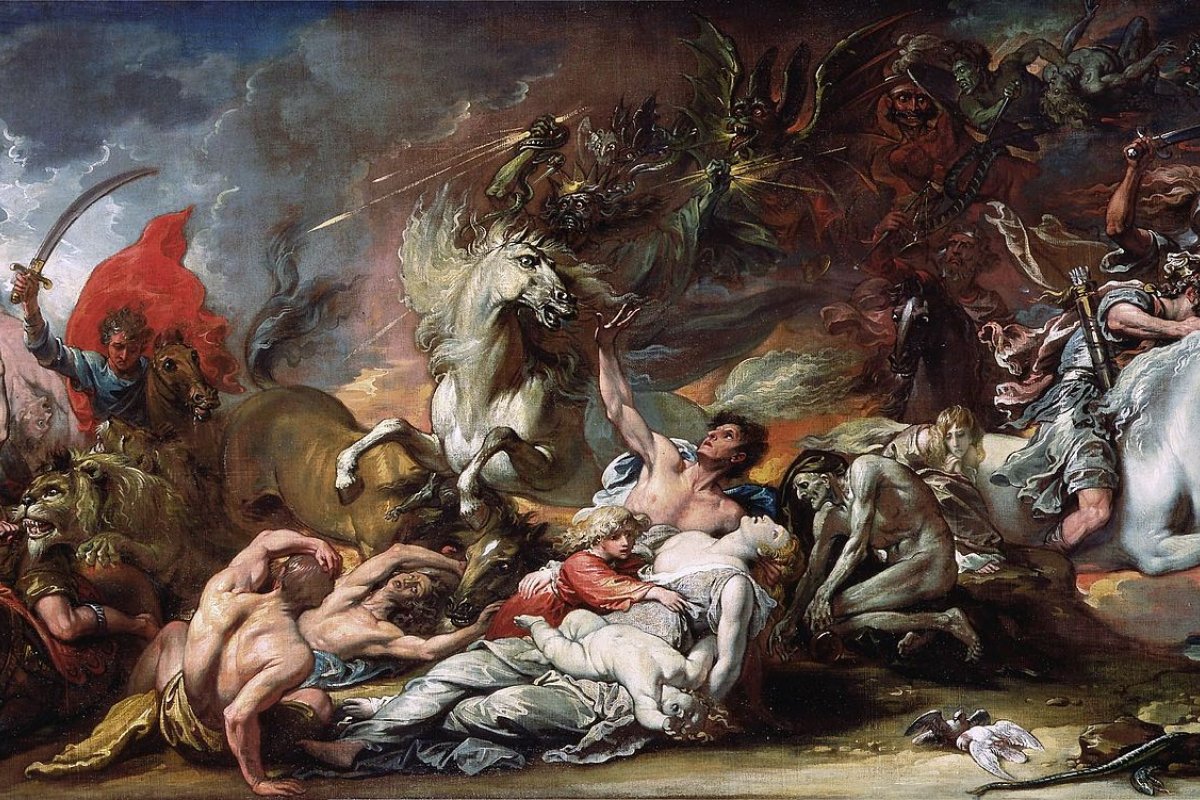
Plagues and the Pale Rider: Our Present Apocalypse
How ancient religious themes can help us make sense of the global pandemic and its socioeconomic fallout
With his genius for perceiving the mixture of things religious and public, Martin Marty in a recent Sightings column, titled “Hope in the Midst of Apocalypse,” noted, “Cultural observers are prone, for better or worse, to resurrect historic terms in an effort to interpret events in the present that challenge our ability to understand.” Assigned the role of cultural observer, I stand guilty as charged! The times in which we live challenge understanding and thus spark the quest for means of interpretation.
My guilt is on two points that I note in Marty’s column title. One point of guilt is in following Marty in tracing the idea of apocalypse in our national and global discourse. The second point is in reclaiming the idea of “plagues,” and specifically those plagues from the Hebrew Scriptures—rivers of blood, locusts, lice, frogs—and from the Book of Revelation—the Pale Rider (with a tip of the [cowboy] hat to Clint Eastwood), the sign of death and divine justice. So, first let me retrieve these historic religious terms in order to see what interpretive work, if any, they might do to help us make sense of this strange and uncertain season in which we find ourselves.
“Apocalypse” designates a literary genre developed in postexilic Israelite culture as well as among early Christian communities. Writing in the midst of calamity and oppression, the genre prophetically redirects their vision to the future, thereby opening some possibility for change. Apocalyptic discourse has also enjoyed long and wide currency throughout Western history, especially in stories about the cataclysmic end of the world. But the Greek term—apokalupsis—originally meant to unveil, disclose, or unfold things not previously seen. It is not altogether clear that we are living in the “end of days,” despite what some religious leaders proclaim. What is true and knowable, however, is that things previously ignored, denied, or simply unseen are now being unveiled by the COVID-19 global pandemic.
The disclosure wrought by coronavirus brings us to the Pale Rider, one of the Four Horsemen of the Apocalypse found in the vision of John of Patmos (Revelation) and also in the Hebrew Scriptures (Zechariah and Ezekiel). The Pale Rider denotes pestilence and death unveiling and disclosing our situation. He rides, in Revelation 6, with conquest (white), war (red), and famine (black). A rosy picture, yes? And next come the frogs, or so we might guess when there are locusts consuming East Africa, tornadoes destroying cities and towns, financial breakdown, starvation and hunger, as well as the usual travail that benumbs human societies. But the Pale Rider also signals God’s judgment, and so is an instrument of divine justice that polices the world whether on horseback or in the plagues visited upon the Egyptians. What interpretive work can these arcane and anarchic religious forms do for us?
The plagues of ancient Egypt exposed an oppressive and tyrannous social system run by the whim and will of a Pharaoh who was blind to the plight of enslaved peoples. In Revelation, the machinery of oppression, blindness, and denial is Imperial Rome (and we might add Emperor worship as well). The bubonic plague rode black rats on merchant ships as a global pandemic killing millions of people. Traditional apocalyptic discourse and events expose wretched social conditions and the reason for people’s blindness. We might call this “ancient ideology critique.”
What has our Apocalypse disclosed to us? First, poverty and gross economic inequality traffic together in the hidden depths of the global economic order—the Black horseman of John’s Apocalypse. COVID-19 rides on the back of economic forces controlled by the global 1% and the withdrawal of nations from cooperation to focus on nationalistic self-interest. The forms are many, of course: attacks on the World Health Organization, delay of aide, the hoarding of medical supplies, etc. The result is unjust distributions of both wealth and death. The rate of death from COVID-19 among the poor and racial minorities is significantly higher than that of wealthy and middle-class white folks. Low-wage service workers, nursing home staff (and residents), bus drivers, and the vulnerable populations who rely on them have been especially affected as a result of this pestilent inequality. And matters are worse (if that is possible) when we consider prison systems around the world. Whether locked behind bars or imprisoned in slums, people are left to fend for themselves and too often die. More than ever before, it is now obvious that the economic order of wealthy nations is dependent on the poor who are subjected to the unrelenting gallop of the pandemic.
If the intimate connection of poverty and disease is now revealed, so too, it seems, is the ambiguity of human sociality. We are so thoroughly social creatures that for many people shelter-in-place orders are almost unbearable. From the wit of late-night comics, to casual conversation, to people around the nation and the world singing in the night, or, elsewhere, protesting against these directives, it seems that for many the pain of loneliness and isolation has been disclosed by the pandemic. How is it, we might ask, that we cannot bear this solitude? Have our inner lives been so hollowed out by endless consumption and mindless social distractions that to abide with ourselves is worse than death? Or is it the justified fear of economic ruin or of dying alone and being buried without loved ones to mourn? This same ambiguity of being social creatures—that we must bear our own lives with, for, and in contention with others—sparks selfless dedication by doctors, nurses, police, and so many others to fight the virus and keep life going. Surely, the next generation will ask, “So what did you do during the great pandemic?” Let us hope that we can stand worthy of what is disclosed about our being social animals. If not, the Red (war) and White (conquest) Riders might set out across the world, and peoples will clash amid the heat of disease.
This global pandemic, our apocalypse, ultimately unveils the moral condition of nations and their citizens. Like all things human, it is an ambiguous condition, due to the deep entanglements between our finitude and the justice of lives and societies. Some religious leaders, supposedly like prophets of old, might proclaim that sin is the cause of the disease. They are wrong. And yet, it is true that our personal and social lives can either help to stop the Horsemen or to prepare their way. What comes to light, what was there and yet ignored and unseen, is the fragility of life that should awaken us to the truth of our condition. We can only hope that people do not turn a blind eye to the understanding made possible by historic terms.
Sightings is edited by Joel Brown, a PhD Candidate in Religions in the Americas at the Divinity School. Sign up here to receive Sightings via email. You can also follow us on Facebook and Twitter. The views and opinions expressed in this article are those of the author and do not necessarily reflect the position of the Marty Center or its editor.
Image: Death on a Pale Horse (1796) by Benjamin West. (Photo: Courtesy of Wikimedia Commons)


